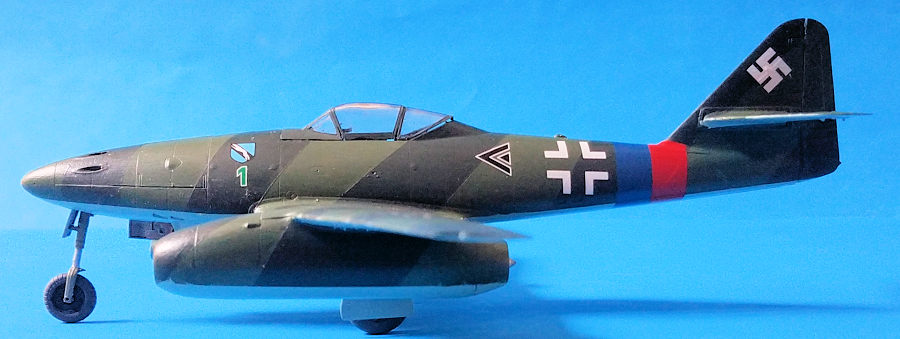
Tamiya 1/48 Me-262A-1a
| KIT #: | 61087 |
| PRICE: | 40 euros |
| DECALS: | Four options |
| REVIEWER: | Francisco Santoro |
| NOTES: |
Good
fitting kit. |

| HISTORY |
From the kit's instructions: "Development of the Me 262, the first
practical jet powered fighter in the world, started in 1939. In July 18th 1942,
Me 262V3 made its flight with two Junkers Jumo 004 jet engines. After prototypes
featuring nose housed landing gear and improved Jumo 004B engines, the first
production model of the Me 262 was completed. Capable of 870km/h top speed, the
Me 262 featured 18,5 degree rec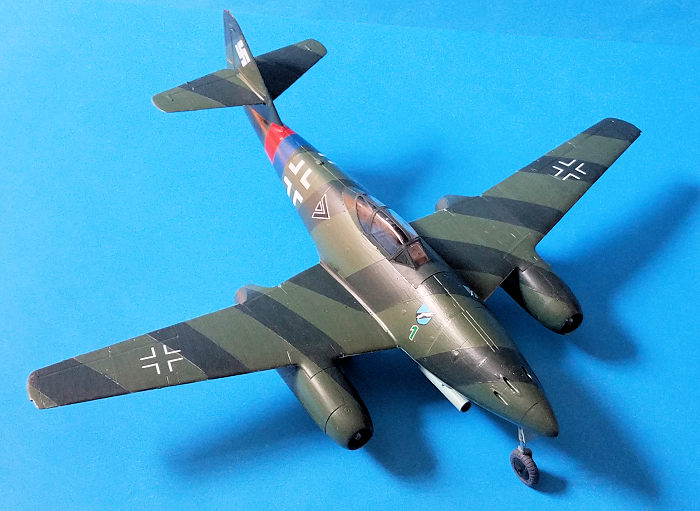 eding wings. With Allied bombing raids on the
German homeland were rapidly intensifying, the Luftwaffe proposed the hastened
deployment of the of the revolutionary Me 262 as a jet fighter/interceptor.
However, Hitler issued strict contrary orders prioritizing the deployment of the
A-2a fighter bomber version of the Me 262. Despite these orders, the A-1a
assigned to Me 262 test/training units (Ekdo 262) were deployed to intercept and
successfully shot down Allied Mosquitoes and Spitfires. On September 1944, the
first practical unit was organized and on November 4th, full scale production of
the Me 262A-1a was permitted at last. Me 262A-1a fighters were assigned to units
such as JG7 (organized based on Ekdo 262) and KG (J) 54 (re-orginised from
bomber unit to fighter unit). On April 1945, just before the end of WW2,
Lieutenant Galland organized an elite unit of ace piloted Me 262A-1a fighters as
JV44. Although the Luftwaffe was on its last wing, ace flown Me 262A-1a fighters
packed with deadly armaments of four MK108 30mm cannons, as well as W.Gr 21 and
R4M air-to-air rockets continued to threaten Allied aircraft until the end of
the war."
eding wings. With Allied bombing raids on the
German homeland were rapidly intensifying, the Luftwaffe proposed the hastened
deployment of the of the revolutionary Me 262 as a jet fighter/interceptor.
However, Hitler issued strict contrary orders prioritizing the deployment of the
A-2a fighter bomber version of the Me 262. Despite these orders, the A-1a
assigned to Me 262 test/training units (Ekdo 262) were deployed to intercept and
successfully shot down Allied Mosquitoes and Spitfires. On September 1944, the
first practical unit was organized and on November 4th, full scale production of
the Me 262A-1a was permitted at last. Me 262A-1a fighters were assigned to units
such as JG7 (organized based on Ekdo 262) and KG (J) 54 (re-orginised from
bomber unit to fighter unit). On April 1945, just before the end of WW2,
Lieutenant Galland organized an elite unit of ace piloted Me 262A-1a fighters as
JV44. Although the Luftwaffe was on its last wing, ace flown Me 262A-1a fighters
packed with deadly armaments of four MK108 30mm cannons, as well as W.Gr 21 and
R4M air-to-air rockets continued to threaten Allied aircraft until the end of
the war."
| THE KIT |
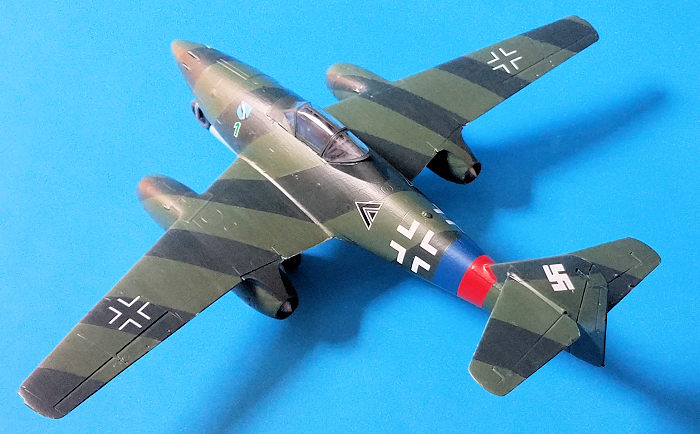 Tamiya's Me 262A-1a has 6 sprues, 5 in grey
plastic, one a clear one. There's also a metal weight included in order to give
the aircraft enough nose weight to avoid it being a tail-sitter. The parts are
cleanly moulded in light grey, with engraved panel lines. Clear parts have
cleanly defined frames and will be easy to mask.
Tamiya's Me 262A-1a has 6 sprues, 5 in grey
plastic, one a clear one. There's also a metal weight included in order to give
the aircraft enough nose weight to avoid it being a tail-sitter. The parts are
cleanly moulded in light grey, with engraved panel lines. Clear parts have
cleanly defined frames and will be easy to mask.
There are a total of four decal options to choose from:
1) Rudolf Sinner's W.Gr21 equipped Me 262A-1a Green 1, III/JG7 based at Brandenburg-Briest in 1945, with an RLM 82/83 striped camouflage pattern and RLM 76 undersides.
2) Heinz Bär's Me 262A-1a Red 13, of III/EJG2, based at Lechfeld, painted in RLM 74/75/76, though I think the camouflage should be painted in RLM 81/82 for the upper surfaces.
3) Johann Karl Müller's Me 262A-1a Red S of JV44, based at Brandenburg-Briest, March 1945. It is painted in RLM 81/82/76.
4) Hans Guido Mutke´s Me 262A-1a White 3, 9 Staffel of III/JG 7, based at Fürstenfeldbruck, April 1945. It is painted in RLM 81/82/76 and equipped with the R4M Orkan air-to-air rockets.
| CONSTRUCTION |
I began by painting all the cockpit parts in RLM 66 (Revell 78), and also painted the cockpit's firewalls in a steel colour (Revell 91). When those parts were dry, they were glued together.
I next turned my attention to the gun bay.
Since I was building a sealed aircraft, I just built the guns and glued it to
the metal weight with
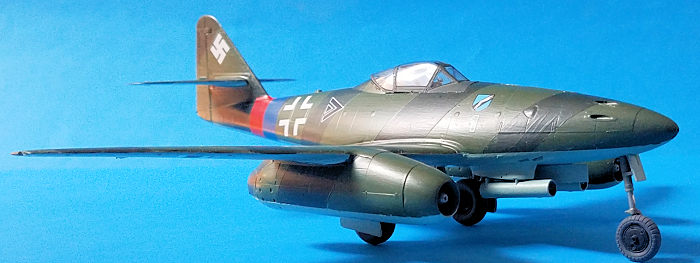 epoxi glue. It is at this time that you have to glue to
the metal weight the nose wheel bay. Tamiya also tells you to install the
landing gear strut at this time, but it can be added later in the build.
epoxi glue. It is at this time that you have to glue to
the metal weight the nose wheel bay. Tamiya also tells you to install the
landing gear strut at this time, but it can be added later in the build.
With a completed cockpit and nose gear bay, I glued them to the right fuselage half and left it to dry. The cockpit sidewalls are also painted in steel by the way.
Next came the wings. These are a top and bottom assembly. I first painted the rear landing gear bulkheads in steel, and then glued them to the bottom wing. With that dry, I glued the two upper halves of the wings to the bottom half.
After assembling the wings, I turned back my attention to the fuselage halves, which were glued together. When the fuselage halves were dry, I glued the wings to it.
The engines came next, these are easy to build and once finished, were glued to the wings.
| COLORS & MARKINGS |
I decided to build Rudolf Sinner's Me 262 with
the stripes, painted in RLM 82/83 and 76 for the undersides. Since I didn´t have
RLM 82/83, and I also read in Britmodeller that the paint stocks of the earlier
colours should be exhausted, I resorted to using RLM 70/71 for the upper. I
painted the whole upper surface of the aircraft in RLM 71. Once it was dry, I
masked the surfaces and painted the RLM 70 for the stripes. When eve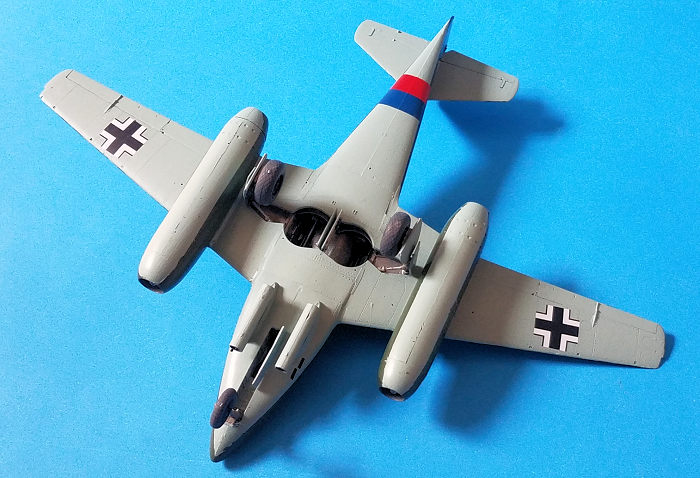 rything was
dry, I varnished the plane with two coats of Revell´s Gloss varnish, to ready
the aircraft for the decals.
rything was
dry, I varnished the plane with two coats of Revell´s Gloss varnish, to ready
the aircraft for the decals.
One advice I was told, is to use hot water with decals from Japanese manufacturers, so they become more flexible and sink into the panel lines better. I began decalling the aircraft by applying the JG7 fuselage band, and then moved forward by adding the Balkenkreuzes of the fuselage, the Chevrons, and the Balkenkreuzes of the wings. After letting the decals set for ten minutes, I brushed some Microsol over them, and let them to dry overnight.
The next day, I removed what remained of the setting solution with some water, and them brushed the model with two coats of Revell's Matt Varnish.
I painted the landing gear doors in steel for the insides and RLM 76 for the outside. The landing gear struts were painted in RLM 02 and steel for the moving parts of the landing gear. The wheel's hubs were painted in matt black, with the tyres being painted in Revell 78.
Before glueing the main gear struts, I glued the retraction arms, and then I glued the landing gear struts in place. After letting the glue to dry, I glued the wheels, glued the gunsight in place, painted and glued the clear parts, and call the model finished.
| CONCLUSIONS |
Another easy kit from Tamiya, which I thoroughly enjoyed building, especially the painting stage. Highly
recommended.
19 May 2020
Copyright ModelingMadness.com
If you would like your product reviewed fairly and fairly quickly, please contact the editor or see other details in the Note to Contributors.
Back to the Main Page Back to the Review Index Page Back to the Previews Index Page